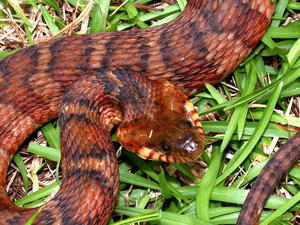Banded water snake facts for kids
The banded water snake (also called the southern water snake) is a type of snake that loves water. Its scientific name is Nerodia fasciata. These snakes are not venomous, meaning they are not dangerous to people. They live mostly in water and are found only in the central and southeastern parts of the United States.
Quick facts for kids Banded water snake |
|
|---|---|
 |
|
| Conservation status | |
| Scientific classification | |
| Genus: |
Nerodia
|
| Species: |
fasciata
|
| Synonyms | |
|
|
Contents
Where do Banded Water Snakes Live?
The banded water snake naturally lives in many states. You can find them from Indiana down to Louisiana. They also live across to Florida in the east.
Banded Water Snakes in New Places
Sometimes, these snakes are found in places they don't usually live. In 1992, some were seen in California. This was discovered by the US Fish and Wildlife Service (USFWS).
Later, in 2009, over 300 banded water snakes were caught. This happened in neighborhoods near Los Angeles. Then, in 2016, more were found near Yuma, Arizona. This area is close to the Colorado River. Many snakes were caught there, showing they are now living and growing in these new places.
What do Banded Water Snakes Look Like?
Adult banded water snakes are usually about 61 to 107 centimeters (24 to 42 inches) long. The longest one ever found was about 159 centimeters (62.5 inches) long. An average adult snake weighs about 464 grams (16 ounces).
Colors and Patterns
These snakes are often gray, greenish-gray, or brown. They have dark bands or stripes across their bodies. Some snakes are so dark that their patterns are hard to see. They have flat heads and strong, heavy bodies.
How They Protect Themselves
If a banded water snake feels scared or bothered, it can release a stinky liquid. This smell helps to keep predators away.
Mistaken Identity
Because of how they look, people often confuse them with other snakes. They are sometimes mistaken for the cottonmouth snake. Cottonmouths are venomous, but banded water snakes are not.
Where do Banded Water Snakes Hang Out?
Banded water snakes love freshwater. They live in many different watery places. You can find them in lakes, marshes, ponds, and streams.
What do Banded Water Snakes Eat?
These snakes mainly eat fish and frogs. They have a special sense organ called the vomeronasal organ. This organ helps them find their prey. It can detect certain proteins in the slime on fish and frogs.
How do Banded Water Snakes Have Babies?
Banded water snakes give birth to live young. They do not lay eggs. This is called being ovoviviparous. A mother snake can have many babies at once. The number of babies can range from 9 to 50. Newborn snakes are usually about 20 to 24 centimeters (8 to 9.5 inches) long.
Types of Banded Water Snakes
There are three main types, or subspecies, of the banded water snake:
- N. f. confluens
- N. f. fasciata
- N. f. pictiventris – This one is also known as the Florida banded water snake.
Images for kids



